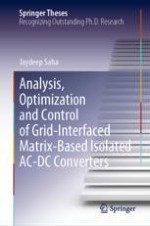This book presents novel contributions in the development of solid-state-transformer (SST) technology both for medium-voltage (MV) and low-voltage (LV) utility grid interfaces, which can potentially augment the grid modernization process in the evolving power system paradigm. For the MV interface, a single-stage AC-DC SST submodule topology has been proposed, and its modulation and soft-switching possibilities are analysed, experimentally validated and adequately benchmarked. A control scheme with power balance capability among submodules is developed for MV grid-connected single-stage AC-DC SST for smooth operation under inevitable parameter drift scenario, and experimental validation shows excellent performance under drastic load change conditions. A novel machine learning-aided multi-objective design optimization framework for grid-connected SST is developed and experimentally validated, which equips a power electronics design engineer with meagre computational resources to find out the most optimal SST design in a convenient time-frame. This book has also contributed towards the development of dual-active-bridge (DAB)-type and non-DAB-type LV grid-interfaced isolated AC-DC converters by providing solutions to specific topology and modulation-related shortcomings in these two types of topologies. A comprehensive comparison of the DAB and non-DAB-type LVAC-LVDC converters reveals the superiority of DAB-type conversion strategy.
